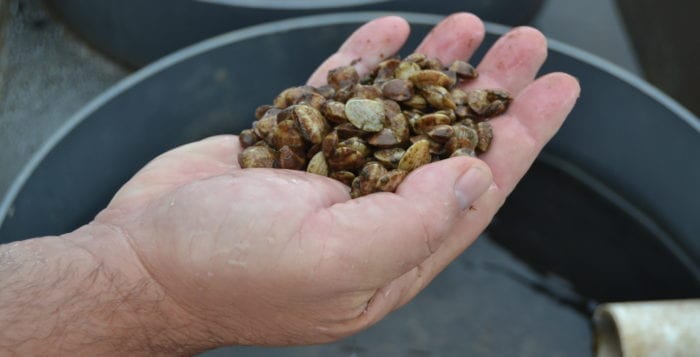By Alex Petroski
Restoring Long Island’s coastal waters as a haven for shellfish to thrive has been a multidecade battle for the Town of Brookhaven. This year, it has added some artillery to the fight in the form of a public-private-nonprofit partnership born in the spirit of sustainability and recycling.
In the 1800s, Long Island was considered the oyster capital of the world, according to Maureen Dunn, water quality scientist at Seatuck Environmental Association, a nonprofit dedicated to preserving Long Island’s wildlife and environment.
“So, to think that there’s virtually no wild oysters in the South Shore is incredible, but it’s really something that we can fix,” Dunn said Sept. 7 at Brookhaven’s shellfish hatchery located on the shores of Mount Sinai Harbor.
For more than 30 years, Brookhaven has been buying juvenile clams and oysters when they are just a millimeter in size, partially maturing them at the town’s hatchery and strategically returning them to North and South Shore waters in an effort to boost the population. Tom Carrano, the town’s assistant waterways management supervisor who has overseen this process since taking the position in the early ’80s, is set to retire imminently.
“Realistically, clams and oysters are the only natural resource the town actually owns because we own the bay bottom,” he said. “It’s our responsibility to make sure that there is sufficient quantities of these animals.”
To aid in fulfilling that responsibility, beginning this year the town has partnered with Seatuck and so far five restaurants to spearhead a program called Half Shells for Habitat. The program entails the restaurants setting aside shells from eaten clams and oysters; collecting them; delivering them to the town’s composting facility in Manorville where they are aged in the sun for six months to a year to ensure viruses and bacteria are not inhabiting the discarded shells; bringing the shells to the hatchery to allow the tiny shellfish to adhere to the larger shells, building what essentially amount to shellfish reefs; and then returning them to the water in the hopes of growing new shellfish.
The town has the capability to grow more than 3 million shellfish in its hatchery per year, and officials believe the use of mature shells will give them a better chance at maturation and warding off predators. Creating the shellfish reefs has several other benefits. The juvenile shellfish require a hard bottom to survive, which the reefs can provide. They also can work as erosion control if placed properly, can counteract the effects of water acidification spurred by climate change and also help to filter algae from the water.
“As CO2 levels in the atmosphere go up, ocean and coastal acidification become more of a concern,” said Anthony Graves, Brookhaven’s chief environmental analyst.
He said taking the shells out of the town’s solid waste stream and using them to improve water quality by staving off erosion and stimulating shellfish growth is a “win-win-win” for the environment.
“It’s tremendous how far we’ve come,” Carrano said, reflecting on the evolution of the operation of shellfish seeding in the town from when he started in his role. “When I started we were growing 100,000 clams. Now we’re growing a million and a half, close to 2 million clams this year and 2 million oysters. The town has been very generous and forthcoming in pushing this program and allowing it to move forward.”
Brookhaven Supervisor Ed Romaine (R) said he would like to see New York adopt a similar law to the state of Maryland’s, which prohibits discarding shells in landfills.
“We’ve made a major commitment to restocking our bays, our harbor ways, our Sound, doing what we can do to restore the balance of nature,” he said. “It’s a cumulative battle, but it’s a battle that we’ve joined, it’s a battle that we intend to continue to fight because we think it’s important not only for the health of the bay, but also to ensure that the bay or harbor can support clams and oysters.”
Currently five restaurants have signed on to participate in the program — Catch Oyster Bar in Patchogue, Prime in Huntington, H2O Seafood & Sushi in East Islip and Tellers: An American Chophouse in Islip — though the town is looking for more. Prior to placing shellfish reefs back in the water, Graves said the town will need permission in the form of a permit from the state Department of Environmental Conservation.





